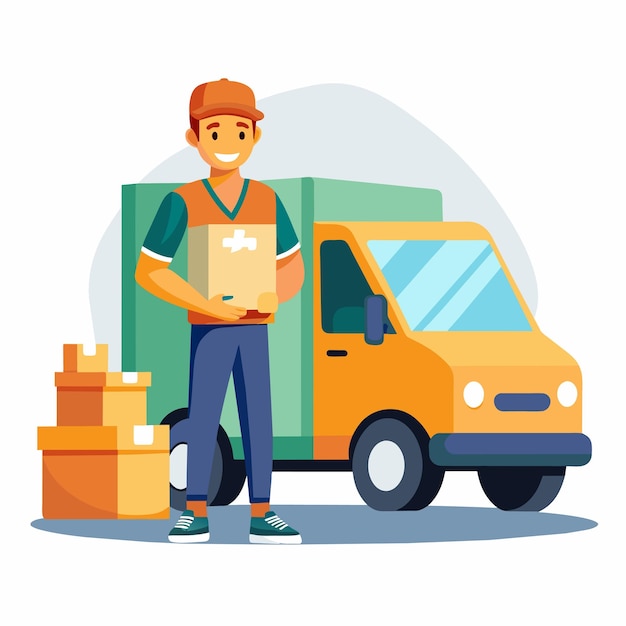In today's fast-paced world, the courier delivery industry is evolving rapidly, driven by technological advancements. An efficient and user-friendly app can significantly enhance courier services by streamlining operations and improving customer satisfaction.
This guide will provide a step-by-step approach to building a successful Uber for Courier Services App, focusing on planning, design, development, and launch.
Planning and Requirements Analysis
Identifying Business Objectives
Before diving into app development, it's crucial to define your business objectives. Determine what you want to achieve with your Uber for Courier Services App. Are you aiming to improve delivery efficiency, reduce operational costs, or enhance customer experience?
Understanding your goals will help shape the app's features and functionalities. Clearly defined objectives will also guide your decisions throughout the development process.
Market Research
Conducting thorough market research is essential to understand the competitive landscape and identify opportunities. Analyze existing courier apps to see what they offer and where they fall short. Identify gaps that your app can fill and what unique features you can offer to stand out. Understanding customer preferences and pain points will help tailor your app to meet their needs effectively.
Defining Functional Requirements
Create a detailed list of the functional requirements for your Uber for Courier Services App. Essential features might include real-time tracking, efficient order management, user profiles, and secure payment integration.
Specify any additional features, such as in-app chat, notifications, and a rating system. Documenting these requirements will ensure that the development team understands what needs to be built and helps in creating a detailed project plan.
Design and User Experience
User Interface (UI) Design
The user interface (UI) is crucial for creating a positive first impression and ensuring that users can navigate the app easily. Design a clean and intuitive UI for both customers and couriers. Use clear visual elements and ensure that the app's navigation is straightforward. Consistency in design across different screens and devices will enhance usability and make the app more accessible to a wider audience.
User Experience (UX) Design
Focus on creating an excellent user experience (UX) by designing user flows and wireframes. Outline how users will interact with the app, from placing an order to tracking delivery. Prioritize ease of use, accessibility, and a seamless experience. Implement feedback mechanisms to gather user input and continuously improve the UX based on real user interactions.
Prototyping and Testing
Develop prototypes to visualize the app's layout and interactions before full-scale development begins. Conduct usability testing with a sample of target users to identify any issues or areas for improvement. Gather feedback on the app's design, functionality, and overall user experience. Iterating on the design based on this feedback will help create a more effective and user-friendly app.
Development Process
Choosing the Technology Stack
Selecting the right technology stack is vital for building a robust Uber for Courier Services App. Choose technologies that offer scalability, security, and performance. Decide on programming languages, frameworks, and databases that best fit your app's requirements. Consider factors such as the expected number of users, data handling needs, and integration capabilities with third-party services.
App Development Phases
Front-End Development
The front-end development phase involves building the app's user interface and implementing interactive elements. Ensure that the design is responsive and compatible across various devices and screen sizes. Focus on creating a smooth and engaging user experience by optimizing loading times and ensuring that all UI components function correctly.
Back-End Development
In the back-end development phase, focus on creating the server-side logic, databases, and APIs. This includes implementing features such as order management, user authentication, and payment processing. Ensure that the back-end is scalable and secure, with robust data handling and efficient server management to support the app's functionality.
Integration and Testing
Integrate third-party services such as payment gateways, mapping APIs, and communication tools to enhance the app's functionality. Conduct rigorous testing to ensure that all features work as expected and that the app performs well under various conditions. Perform user acceptance testing (UAT) to validate that the app meets user expectations and address any issues before the official launch.
Deployment and Launch
Preparing for Launch
Before launching your Uber like courier delivery app, prepare the deployment environment and configure servers. Ensure that all app components are functioning correctly and that you have set up necessary monitoring tools.
Develop marketing materials and strategies to promote the app and generate buzz before the launch. Comply with app store guidelines and legal requirements to ensure a smooth launch process.
Post-Launch Activities
After the app is launched, monitor its performance and gather user feedback to identify areas for improvement. Address any issues or bugs that arise promptly and release updates as needed. Implement a maintenance plan to ensure that the app remains functional and up-to-date, addressing any evolving user needs and industry trends.
Marketing and User Acquisition
Developing a Marketing Strategy
A well-defined marketing strategy is crucial for attracting users to your Uber for Courier Services App. Identify your target audience and choose effective marketing channels to reach them. Develop promotional campaigns and content that highlight the app's features and benefits. Leverage social media, search engine optimization (SEO), and online advertising to drive downloads and increase visibility.
Building Partnerships
Forming strategic partnerships can help boost your app's reach and credibility. Collaborate with businesses and influencers to promote the app and expand its user base. Explore partnerships with logistics companies and courier services to enhance your app's offerings. Implement referral programs and incentives to encourage existing users to refer new customers, further driving growth.
Scaling and Future Enhancements
Analyzing User Data
Utilize analytics tools to monitor user behavior and app performance. Track key metrics such as user engagement, retention rates, and order volumes to identify trends and areas for
improvement. Analyzing user data will provide insights into how the app is being used and help you make informed decisions about future updates and enhancements.
Implementing New Features
Based on user feedback and market trends, plan and implement new features to enhance the app's value and maintain competitiveness. Regularly update the app to address evolving user needs and industry developments. Explore opportunities to expand into new markets or add new services, keeping the app relevant and appealing to a broad audience.
Also read: How To Create A Successful Social Media Marketing Strategy?
Conclusion
Developing an Uber for Courier Services App requires careful planning, design, and execution. By following this comprehensive guide, you can build a high-performance app that meets user needs and stands out in the competitive courier delivery market.
Emphasize the importance of ongoing improvement and adaptability to ensure long-term success and growth in the dynamic courier services industry.






Comments